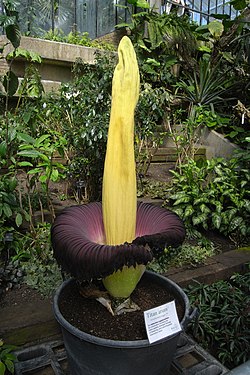Amorphophallus titanum
| Habit | bulbous
| |
|---|---|---|
| Height: | ⇕ | 6 m"m" can not be assigned to a declared number type with value 6. |
| Width: | ⇔ | 5 m"m" can not be assigned to a declared number type with value 5. |
| Lifespan: | ⌛ | perennial |
| Origin: | ✈ | Sumatra |
| Exposure: | ☼ | part-sun |
|---|---|---|
| Water: | ◍ | moist |
| Features: | ✓ | flowers, foliage |
| Flower features: | ❀ | purple, black, white |
|
Araceae > |
titanum > |
The titan arum or Amorphophallus titanum (from Ancient Greek amorphos, "without form, misshapen" + phallos, "penis", and titan, "giant") is a flowering plant with the largest unbranched inflorescence in the world. It thrives at the edges of rainforests near open grasslands. Though found in many botanic gardens around the world it is still indigenous only to the tropical forests of Sumatra. Due to its fragrance, which is reminiscent of the smell of a decomposing mammal,[1] the titan arum is also known as a carrion flower, the "Corpse flower", or "Corpse plant".
The titan arum's inflorescence can reach over 3 m ft 0 in circumference. Like the related cuckoo pint and calla lily, it consists of a fragrant spadix of flowers wrapped by a spathe, which looks like the flower's single petal. In the case of the Titan Arum, the spathe is green on the outside and dark burgundy red on the inside, and deeply furrowed. The spadix is hollow and resembles a large loaf of French bread. The upper, visible portion of the spadix is covered in pollen, while its lower extremity is spangled with bright red-orange carpels. The "fragrance" of the inflorescence resembles rotting meat, attracting carrion-eating beetles and Flesh Flies (family Sarcophagidae) that pollinate it. The flower's deep red color and texture contribute to the illusion that the spathe is a piece of meat. During bloom, the tip of the spadix is approximately human body temperature, which helps the perfume volatilize; this heat is also believed to assist in the illusion that attracts carcass-eating insects.
Both male and female flowers grow in the same inflorescence. The female flowers open first, then a day or two following, the male flowers open. This prevents the flower from self-pollinating.
After the flower dies back, a single leaf, which reaches the size of a small tree, grows from the underground corm. The leaf grows on a semi-green stalk that branches into three sections at the top, each containing many leaflets. The leaf structure can reach up to 6 m ft tall and 5 m ft across. Each year, the old leaf dies and a new one grows in its place. When the corm has stored enough energy, it becomes dormant for about 4 months. Then, the process repeats.
The corm is the largest known, weighing around 50 kg lb .[2] When a specimen at the Princess of Wales Conservatory, Kew Gardens, was repotted after its dormant period, the weight was recorded as 91 kg lb .[3]
The titan arum grows in the wild only in the equatorial rainforests of Sumatra, Indonesia. The plant flowers only infrequently in the wild and even more rarely when cultivated. The number of cultivated plants has increased in recent years, and it is not uncommon for there to be five or more flowering events in gardens around the world in a single year. The titan arum is more commonly available to the advanced gardener due to pollination techniques.
The record for tallest bloom in cultivation is for a Titan arum, which bloomed on 20 October 2005 at the botanical and zoological garden Wilhelma in Stuttgart, Germany. The bloom reached a height of 2.94 m (9 ft. 6 in.).
Cultivation
Propagation
Pests and diseases
Varieties
Gallery
References
- ↑ "History and Botany of the Titan Arum" from the Brooklyn Botanic Garden
- ↑ Titan Arum Blooming
- ↑ About titan arum
External links
- w:Amorphophallus titanum. Some of the material on this page may be from Wikipedia, under the Creative Commons license.
- Amorphophallus titanum QR Code (Size 50, 100, 200, 500)




